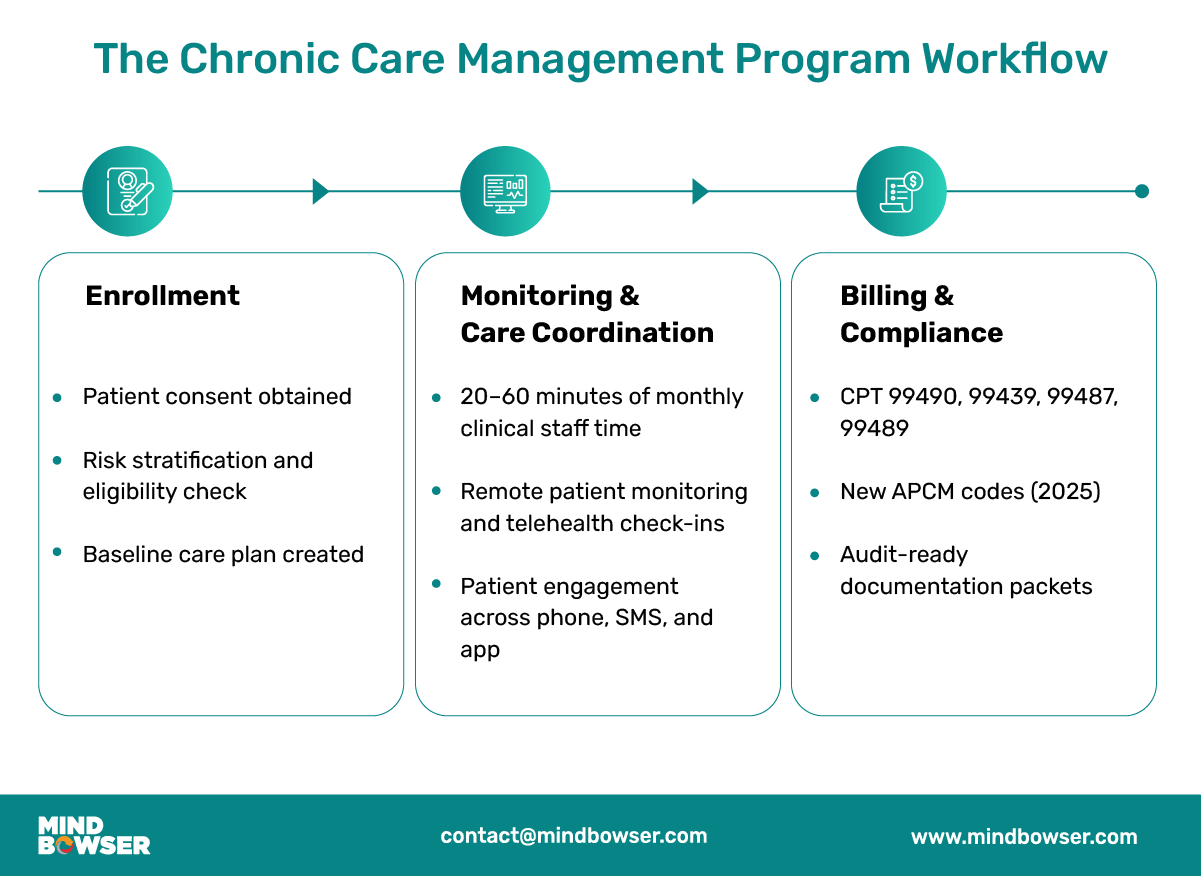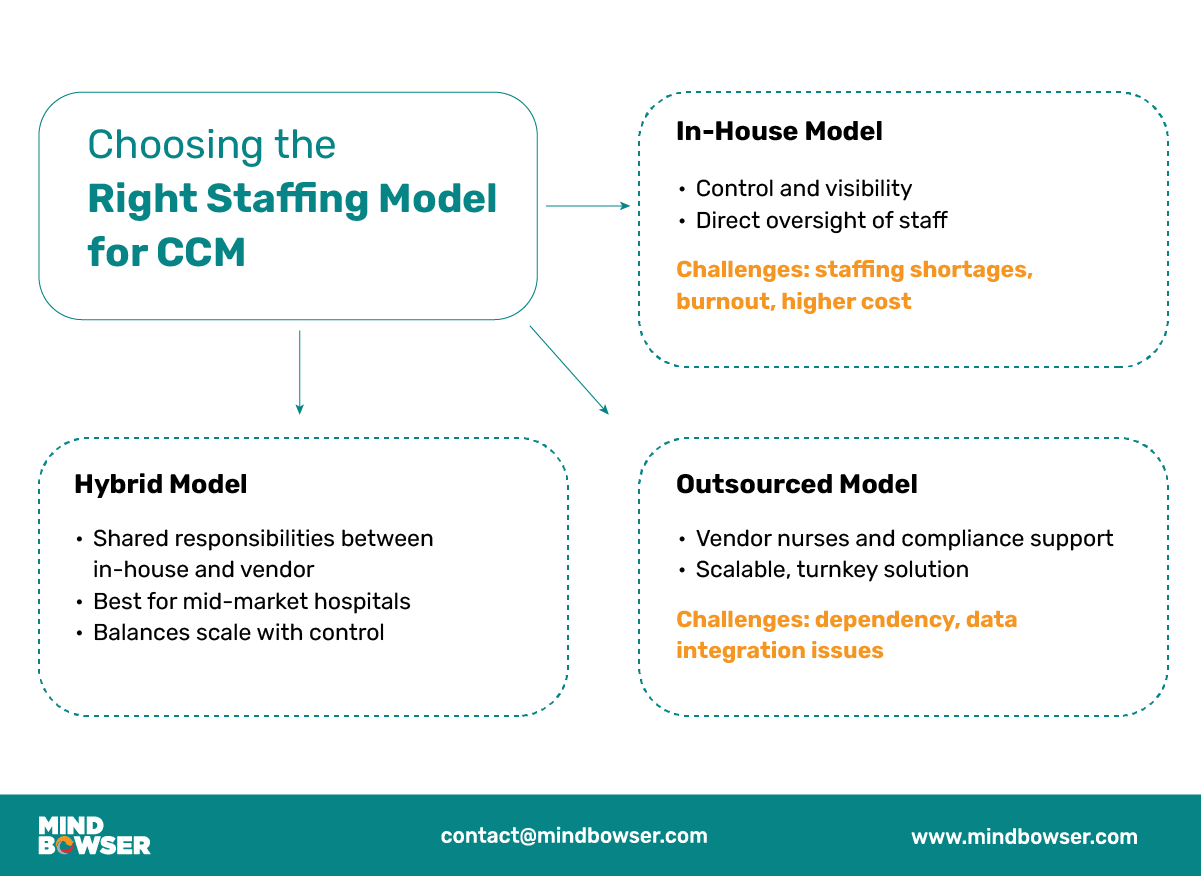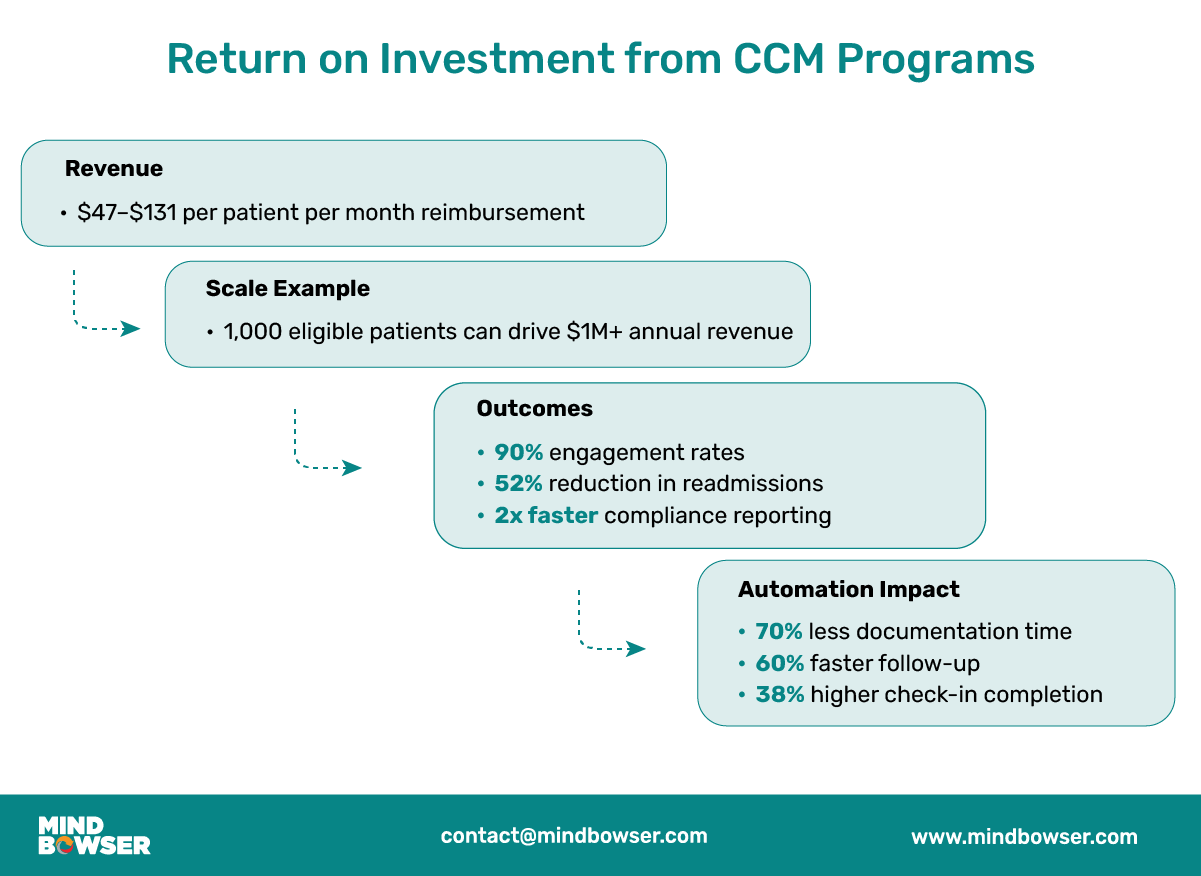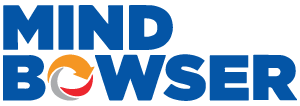A chronic care management program gives hospitals and digital health startups a structured path to improve outcomes and capture CMS reimbursements. From patient enrollment through monitoring to billing, the model reduces ER visits, prevents compliance risks, and boosts ROI. The right staffing mix and automation unlock scale. Download the Mindbowser guide for the full roadmap.
The market for chronic care management is no longer a niche initiative; it has become a mainstream approach. In 2024, the U.S. chronic care management (CCM) market is valued between $1.7 billion and $2.2 billion, with some estimates placing it at $6.7 billion. Projections consistently indicate double-digit growth, with estimates ranging from $6 billion to $27 billion by 2030. This rapid expansion is fueled by demographic pressures, the rise of value-based care models, and policy shifts that make CCM programs more financially attractive.
CMS continues to expand reimbursement opportunities, including the introduction of new APCM codes in 2025 that align payments with patient complexity rather than simply time. For hospitals and digital health startups, this shift creates a stronger business case to invest in CCM. A well-designed program not only secures new revenue streams but also positions organizations to thrive under value-based care contracts.
At its core, a chronic care management program is a structured clinical and administrative framework that supports patients with two or more chronic conditions expected to last at least 12 months. It involves creating a personalized care plan, providing ongoing monitoring, coordinating across various specialties, and documenting all touchpoints to ensure compliance. When executed effectively, the model reduces avoidable emergency visits, increases medication adherence, and improves patient satisfaction.
For mid-market hospitals struggling with staffing shortages and administrative burden, or for startups seeking scalable engagement models, CCM programs offer both a clinical and financial lifeline. The ability to capture consistent reimbursements while improving population health outcomes is no longer optional; it is a competitive necessity.
Related read: CCM: Building Compliance-Ready, ROI-Driven Platforms for 2025 and Beyond
Chronic care management (CCM) is a Medicare-supported service model designed to improve care for patients living with two or more chronic conditions that are expected to persist for at least 12 months. These conditions may include diabetes, heart failure, chronic obstructive pulmonary disease, or behavioral health disorders. The goal of CCM is to provide continuous, coordinated care outside of the traditional office visit, enabling providers to improve outcomes while securing predictable reimbursement.
Eligibility hinges on CMS rules. Providers must obtain patient consent, develop a comprehensive care plan, and deliver at least twenty minutes of non-face-to-face clinical staff time each month. Documentation is critical, as CPT codes such as 99490 (non-complex CCM, 20 minutes) and 99439 (each additional 20 minutes) form the backbone of billing. For patients with more complex needs, codes 99487 and 99489 reimburse higher intensity care. In 2025, the introduction of APCM codes further expands reimbursement, aligning payment with patient complexity, including social and behavioral factors.
CCM programs center on three pillars: creating individualized care plans, coordinating across the care team, and ongoing monitoring. This includes medication management, patient education, appointment scheduling, and connecting patients with community or behavioral health resources when needed. Together, these steps form a structured yet flexible framework that can be scaled across hospitals, health systems, and digital health platforms.
Related read: Chronic Care Management Billing in 2025: From CPT Codes to APCM Strategy
CCM programs deliver a measurable impact on both patient health and organizational performance. For patients, they help prevent avoidable hospital visits, reduce emergency room dependence, and improve medication adherence. Care teams can intervene earlier when warning signs emerge, often avoiding costly complications.
Financially, the model creates steady monthly reimbursements. Medicare pays between $47 and $131 per patient per month, depending on the level of complexity and the amount of time recorded. At scale, this revenue can cover staffing costs and generate net new margin for hospitals and practices. For a mid-sized health system with 1,000 eligible patients, a well-run program can drive more than $1 million annually in incremental reimbursement while simultaneously advancing quality metrics.
Strategically, CCM programs align closely with the shift toward value-based care. By reducing readmissions and improving management of chronic conditions, hospitals strengthen their position in risk-based contracts. For digital health startups, CCM represents a scalable service line that integrates RPM, telehealth, and patient engagement tools. In both cases, success requires more than billing codes; it requires building an operational foundation that balances compliance with patient-centered care.
A chronic care management program is not a single intervention; it is a comprehensive approach. It is a continuous cycle that begins with enrollment, moves through monitoring and coordination, and ends with billing and compliance. Each stage requires careful execution to maximize both patient impact and financial sustainability.

The first step is enrolling patients who qualify under CMS guidelines. Eligibility requires at least two chronic conditions that are expected to last a minimum of twelve months. Enrollment begins with informed patient consent, which must be documented in the medical record. This step is often overlooked, but without proper consent, claims can be denied during audits.
Risk stratification follows. Providers use medical histories, lab data, and social determinants of health information to prioritize patients who will benefit most from structured care coordination. High-risk patients, such as those with multiple comorbidities or recent hospitalizations, typically become early candidates. Proper documentation at this stage sets the foundation for compliance and reporting.
Finally, enrollment requires building a baseline care plan. This document summarizes patient conditions, goals, medications, and provider contacts. It also identifies gaps in care, such as overdue screenings or unmanaged risk factors. The care plan must be accessible to both the patient and the broader care team.
Once patients are enrolled, the ongoing work begins. CMS requires that at least twenty minutes of non-face-to-face clinical staff time be provided each month. This typically includes medication reconciliation, appointment scheduling, lab follow-up, and patient education. For patients with more complex needs, sixty minutes of documented time may be required.
Technology has become essential in meeting these requirements. Remote patient monitoring devices transmit blood pressure, glucose, and weight data directly into EHRs. Telehealth platforms allow quick check-ins and counseling sessions. Social determinants data can be integrated to identify barriers, such as housing or transportation, that affect care adherence.
Engagement is the centerpiece of monitoring. Phone calls, secure messages, and app notifications help patients stay on track. The most successful programs use multi-channel communication to reach patients in the format they prefer. This consistent outreach improves adherence rates, reduces avoidable hospital visits, and strengthens patient trust in the care team.
The final step in the workflow is translating care delivery into compliant claims. The CPT codes most commonly used are 99490 for standard CCM and 99439 for additional time. Complex patients are billed under 99487 and 99489. In 2025, new APCM codes will further expand the payment model, with rates adjusted for social and behavioral complexity as well as clinical needs.
Compliance is critical. Documentation must prove that time thresholds were met, that care plans were updated, and that consent was obtained. Many organizations fail audits because of incomplete notes, vague care interventions, or mismatched time logs. To avoid denials, audit-ready packets should include care plan updates, communication logs, and time tracking with staff attribution.
Billing is not the end of the cycle. Instead, it closes the loop and restarts the process with new care plan adjustments for the following month. When executed properly, the workflow becomes a predictable revenue stream that also improves patient health outcomes.
The staffing model chosen to support a chronic care management program often determines whether the program scales smoothly or struggles under operational pressure. Hospitals and digital health startups typically weigh three options: in-house staffing, outsourced partnerships, or a hybrid approach. Each model offers advantages and tradeoffs that need to be considered carefully.

The in-house model places responsibility for CCM directly on hospital or clinic staff. Care coordinators, nurses, and physicians handle enrollment, monitoring, documentation, and billing within the organization’s existing workflows. This model offers maximum control and transparency. Leaders can shape every element of the patient experience, ensure alignment with organizational culture, and maintain full control of protected health information.
However, the challenges are significant. Staffing shortages continue to affect hospitals nationwide, with many systems already stretched by nursing vacancies and administrative backlogs. Recruiting and training new staff to manage CCM requires upfront investment and time. Burnout is a significant concern, particularly when teams must manually track time thresholds and generate audit-ready documentation. In-house models may be sustainable for large health systems with robust staffing pipelines, but for mid-market hospitals, the cost and workload can quickly become a barrier.
The outsourced model involves contracting with a dedicated CCM service vendor. These vendors typically provide care coordinators, clinical staff, compliance expertise, and billing support as a turnkey solution. Outsourcing reduces the burden on internal staff, allowing hospitals to launch programs more quickly. Vendors often specialize in navigating CMS requirements, reducing the risk of audit denials.
Scalability is the key advantage. With an outsourced partner, a hospital can expand its program from dozens to thousands of patients without hiring additional staff. This model also improves cost predictability, since contracts are often structured on a per-patient-per-month basis.
The tradeoff is dependency. Hospitals must ensure that vendor workflows integrate seamlessly with their EHR systems. Communication between outsourced care teams and internal clinicians can be uneven if processes are not clearly defined and documented. Data sharing and interoperability become critical concerns, particularly for organizations that require real-time updates for informed clinical decision-making.
The hybrid model blends internal and outsourced resources. In this approach, hospitals retain oversight of patient engagement and clinical decision-making while outsourcing administrative functions such as billing, compliance audits, or overflow patient monitoring. This model offers flexibility, enabling organizations to allocate internal resources to the most complex patients while ensuring scalability and compliance through external partners.
For mid-market hospitals, the hybrid model is often the most suitable option. It enables them to launch a CCM program quickly with vendor support while gradually building internal capacity. For digital health startups, a hybrid model supports rapid growth while maintaining a measure of control over patient experience and technology integration.
The hybrid approach is not without challenges. Clear governance is required to avoid duplication of effort between internal staff and vendor teams. Workflows must be carefully documented so that all stakeholders understand their responsibilities. When managed effectively, however, the hybrid model strikes a better balance between cost, scalability, and control than either extreme.
From workflow integration to billing optimization, Mindbowser helps you build a sustainable, scalable CCM model that delivers measurable impact.
Even well-designed chronic care management programs can stumble if operational details are overlooked. Hospitals and digital health startups often underestimate the complexity of compliance, patient engagement, and documentation. Recognizing common pitfalls early can prevent revenue leakage, audit denials, and low patient adoption.
Enrollment is more than identifying eligible patients. Programs often fail because consent is not properly obtained or documented. CMS requires explicit patient consent to participate in CCM services, and missing this step is one of the fastest paths to denied claims. Another challenge is the fragmentation of patient records across multiple providers or EHR systems, which can lead to incomplete eligibility assessments. Without a standardized intake process, patients may slip through the cracks, limiting the program’s ability to scale.
Compliance is the backbone of reimbursement. Programs frequently struggle with incomplete or inaccurate documentation of care minutes. CMS requires proof that time thresholds are met, care plans are up-to-date, and interventions are targeted and specific. Generic notes such as “patient called, doing well” do not meet the level of detail auditors expect. Inconsistent tracking of care plan updates, missing medication lists, or vague summaries can all trigger denials. Billing staff must also stay current with changing CPT and APCM rules, as outdated coding practices can create financial risk.
A chronic care management program succeeds only if patients remain active participants. Low engagement rates are a common pitfall. If outreach relies solely on monthly phone calls, patients may disengage or fail to see the value of the service. Language barriers, limited technology literacy, and a lack of multi-channel communication can further depress participation. Without proactive engagement strategies, such as text reminders, app-based education, or community resource referrals, adherence rates drop, and the program struggles to demonstrate its outcomes.
These pitfalls underscore a fundamental truth: CCM is not merely a billing exercise. It is a patient-centric program that demands operational discipline. Avoiding these mistakes requires dedicated processes, technology support, and strong leadership commitment. Programs that address these risks up front are far more likely to achieve both clinical and financial goals.
Automation is no longer optional for hospitals and digital health startups seeking to scale chronic care management programs. The administrative burden of tracking time, updating care plans, documenting interventions, and engaging patients can overwhelm staff if handled manually. Strategic use of automation reduces errors, improves compliance, and creates more time for patient interaction.

One of the heaviest lifts in CCM is documentation. Clinical staff must capture every touchpoint, update care plans regularly, and attribute time correctly for billing. Manual documentation often leads to incomplete notes and missed audit requirements. Automation workflows, such as AI Medical Summary, generate structured clinical notes directly from EHR and patient data. These summaries reduce the risk of vague documentation and ensure that updates meet CMS standards. By streamlining record-keeping, providers can shift focus from paperwork to patient care.
Patient engagement is another area where automation delivers measurable results. Automated call bots and chat-based questionnaires can perform monthly check-ins, collect vital signs, and escalate issues when needed. MedAdhere AI extends this capability by sending reminders via SMS, email, or app notifications to improve medication adherence. Programs using engagement automation report higher patient satisfaction, more consistent monitoring, and fewer missed interventions. These tools are particularly valuable for reaching patients across diverse demographics where staff-driven outreach may not be sustainable.
Care plans are the foundation of a CCM program, but manual updates often cause delays. CarePlan AI addresses this by capturing patient goals and preferences through digital surveys or chat interactions. The tool reduces coordination delays by producing real-time updates and aligning patient-reported goals with provider workflows. Predictive analytics can also be integrated to flag patients at risk of readmission or deterioration. By combining automation with clinical oversight, hospitals create care plans that are both compliant and adaptive to patient needs.
The impact of automation extends beyond efficiency. By cutting administrative effort, these solutions protect staff from burnout and reduce compliance errors that can lead to denials. They also enable programs to expand to hundreds or thousands of patients without proportionally increasing staffing costs. In effect, automation transforms CCM from a labor-intensive service into a scalable clinical and financial engine.
A digital health company partnered with Mindbowser to improve engagement for elderly patients managing multiple chronic conditions. The program integrated remote patient monitoring devices with a patient-friendly mobile app and a centralized care manager portal. This allowed seamless data capture, real-time reporting, and consistent follow-up by care teams.
The result was a 90% engagement rate among elderly patients, far exceeding the industry average. Administrators and care managers reported that report generation and compliance documentation were completed twice as fast as before. Patients responded positively to daily reminders and real-time feedback, which helped keep them aligned with their care plans.
The success of this program demonstrates the importance of intuitive design, device integration, and secure communication. By focusing on patient experience while streamlining backend workflows, the organization created a scalable CCM program that delivered measurable clinical and financial results.
Mindbowser supports hospitals and digital health startups in building scalable, compliant, and ROI-driven chronic care management programs through specialized workflows:
Proof of Impact
Compliance Edge

A chronic care management program is more than a billing exercise. It is a structured model that improves patient outcomes, reduces avoidable hospitalizations, and creates steady reimbursement for providers. Success depends on disciplined enrollment, consistent monitoring, compliant billing, and innovative use of workflows. Hospitals and digital health startups that invest in robust CCM programs today will be better positioned to thrive in the value-based care environment of tomorrow.
A chronic care management program is a structured clinical and administrative model that supports patients with two or more chronic conditions that are expected to last at least 12 months. It includes personalized care plans, monthly monitoring, and coordination across providers, with reimbursement available through CMS CPT and APCM codes.
Hospitals bill for CCM services using CPT codes such as 99490, 99439, 99487, and 99489. Reimbursement is based on documented time and complexity of care. In 2025, new APCM codes will expand billing to include patient complexity factors beyond time alone.
The right staffing model depends on the organization. In-house staffing provides control but can strain resources. Outsourced models offer scalability and compliance expertise. Hybrid models strike a balance between both approaches, making them a strong fit for mid-market hospitals and growth-stage digital health companies.
Common risks include missing patient consent, incomplete documentation of time thresholds, vague care plan updates, and outdated coding practices. These issues often lead to audit denials. Building audit-ready packets and utilizing workflow automation significantly reduces these risks.
Automation streamlines documentation, patient engagement, and updates to care plans. It reduces manual workload, prevents compliance errors, and enables care teams to scale programs without proportionally increasing staff. Automated reminders and monitoring also boost patient adherence and outcomes.

We worked with Mindbowser on a design sprint, and their team did an awesome job. They really helped us shape the look and feel of our web app and gave us a clean, thoughtful design that our build team could...


The team at Mindbowser was highly professional, patient, and collaborative throughout our engagement. They struck the right balance between offering guidance and taking direction, which made the development process smooth. Although our project wasn’t related to healthcare, we clearly benefited...

Founder, Texas Ranch Security

Mindbowser played a crucial role in helping us bring everything together into a unified, cohesive product. Their commitment to industry-standard coding practices made an enormous difference, allowing developers to seamlessly transition in and out of the project without any confusion....

CEO, MarketsAI

I'm thrilled to be partnering with Mindbowser on our journey with TravelRite. The collaboration has been exceptional, and I’m truly grateful for the dedication and expertise the team has brought to the development process. Their commitment to our mission is...

Founder & CEO, TravelRite

The Mindbowser team's professionalism consistently impressed me. Their commitment to quality shone through in every aspect of the project. They truly went the extra mile, ensuring they understood our needs perfectly and were always willing to invest the time to...

CTO, New Day Therapeutics

I collaborated with Mindbowser for several years on a complex SaaS platform project. They took over a partially completed project and successfully transformed it into a fully functional and robust platform. Throughout the entire process, the quality of their work...

President, E.B. Carlson

Mindbowser and team are professional, talented and very responsive. They got us through a challenging situation with our IOT product successfully. They will be our go to dev team going forward.

Founder, Cascada

Amazing team to work with. Very responsive and very skilled in both front and backend engineering. Looking forward to our next project together.

Co-Founder, Emerge

The team is great to work with. Very professional, on task, and efficient.

Founder, PeriopMD

I can not express enough how pleased we are with the whole team. From the first call and meeting, they took our vision and ran with it. Communication was easy and everyone was flexible to our schedule. I’m excited to...

Founder, Seeke

We had very close go live timeline and Mindbowser team got us live a month before.

CEO, BuyNow WorldWide

Mindbowser brought in a team of skilled developers who were easy to work with and deeply committed to the project. If you're looking for reliable, high-quality development support, I’d absolutely recommend them.

Founder, Teach Reach

Mindbowser built both iOS and Android apps for Mindworks, that have stood the test of time. 5 years later they still function quite beautifully. Their team always met their objectives and I'm very happy with the end result. Thank you!

Founder, Mindworks

Mindbowser has delivered a much better quality product than our previous tech vendors. Our product is stable and passed Well Architected Framework Review from AWS.

CEO, PurpleAnt

I am happy to share that we got USD 10k in cloud credits courtesy of our friends at Mindbowser. Thank you Pravin and Ayush, this means a lot to us.

CTO, Shortlist

Mindbowser is one of the reasons that our app is successful. These guys have been a great team.

Founder & CEO, MangoMirror

Kudos for all your hard work and diligence on the Telehealth platform project. You made it possible.

CEO, ThriveHealth

Mindbowser helped us build an awesome iOS app to bring balance to people’s lives.

CEO, SMILINGMIND

They were a very responsive team! Extremely easy to communicate and work with!

Founder & CEO, TotTech

We’ve had very little-to-no hiccups at all—it’s been a really pleasurable experience.

Co-Founder, TEAM8s

Mindbowser was very helpful with explaining the development process and started quickly on the project.

Executive Director of Product Development, Innovation Lab

The greatest benefit we got from Mindbowser is the expertise. Their team has developed apps in all different industries with all types of social proofs.

Co-Founder, Vesica

Mindbowser is professional, efficient and thorough.

Consultant, XPRIZE

Very committed, they create beautiful apps and are very benevolent. They have brilliant Ideas.

Founder, S.T.A.R.S of Wellness

Mindbowser was great; they listened to us a lot and helped us hone in on the actual idea of the app. They had put together fantastic wireframes for us.

Co-Founder, Flat Earth

Mindbowser was incredibly responsive and understood exactly what I needed. They matched me with the perfect team member who not only grasped my vision but executed it flawlessly. The entire experience felt collaborative, efficient, and truly aligned with my goals.

Founder, Child Life On Call

The team from Mindbowser stayed on task, asked the right questions, and completed the required tasks in a timely fashion! Strong work team!

CEO, SDOH2Health LLC

Mindbowser was easy to work with and hit the ground running, immediately feeling like part of our team.

CEO, Stealth Startup

Mindbowser was an excellent partner in developing my fitness app. They were patient, attentive, & understood my business needs. The end product exceeded my expectations. Thrilled to share it globally.

Owner, Phalanx

Mindbowser's expertise in tech, process & mobile development made them our choice for our app. The team was dedicated to the process & delivered high-quality features on time. They also gave valuable industry advice. Highly recommend them for app development...

Co-Founder, Fox&Fork
